Kona Manta Ray Snorkel Guide: Hawaii’s Best Spots
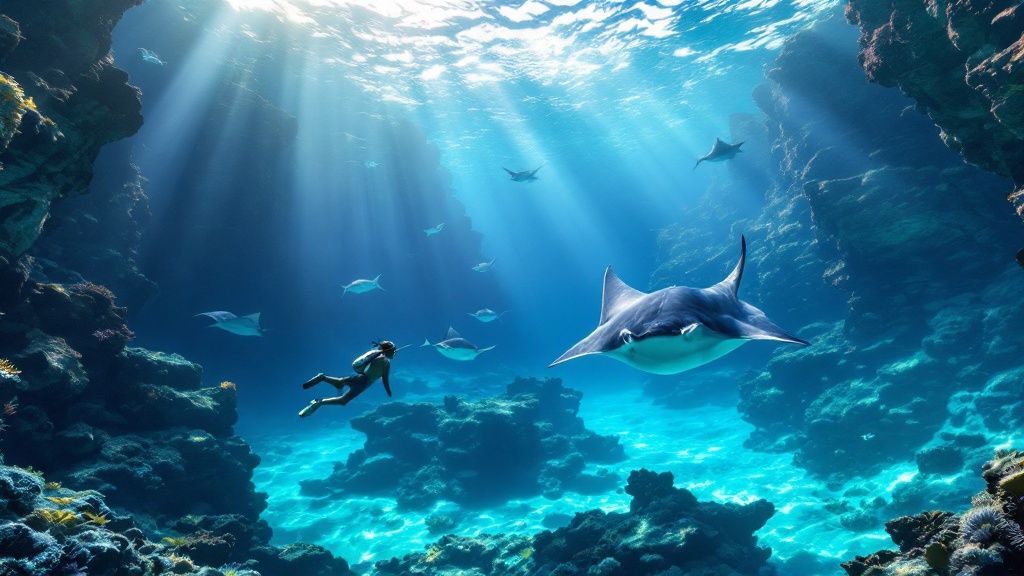
Why Kona Is the Ultimate Manta Ray Snorkel Experience
Kona, Hawaii, isn't just a beautiful island; it's a global hotspot for manta ray encounters. The Kona coast offers a unique combination of natural factors creating an ideal habitat for these gentle giants, making it a truly special snorkeling destination. One key element is the volcanic underwater topography. The slopes and crevices provide shelter and cleaning stations for the mantas. This unique terrain also influences the ocean currents, another vital component of the Kona manta ray experience.
These currents bring nutrient-rich waters to the area, supporting a thriving ecosystem. The currents carry an abundance of plankton, the manta ray's primary food source. This consistent food supply is what draws the mantas to Kona's waters night after night, creating predictable and reliable sighting opportunities for snorkelers. The exceptional water clarity in Kona allows for incredible views of these magnificent creatures.
The Kona Advantage: High Sighting Success Rates
What truly sets Kona apart from other manta ray destinations is the remarkable sighting success rate. Kona is renowned for manta ray snorkeling precisely because of this high rate. On average, snorkelers encounter manta rays between 80% and 90% of the time year-round.
This reliability is attributed to the consistent plankton food source, abundant due to nutrient-rich ocean currents. The unique underwater volcanic topography provides an ideal habitat. Approximately 80,000 people snorkel with manta rays annually in Kona, highlighting its popularity. Discover more insights about Kona's manta ray population here. This high probability of an encounter makes Kona the ultimate manta ray snorkel destination.
A Sustainable Ecosystem for Thriving Mantas
The unique ecosystem in Kona hasn't just attracted manta rays; it's created a sustainable environment where they flourish. The reliable food source, combined with the protective habitat, supports a large and healthy manta ray population.
This has, in turn, driven local conservation efforts. The economic benefits of manta ray tourism have incentivized protecting these animals and their habitat. This creates a cycle of sustainability ensuring future generations will experience the magic of a Kona manta ray snorkel.
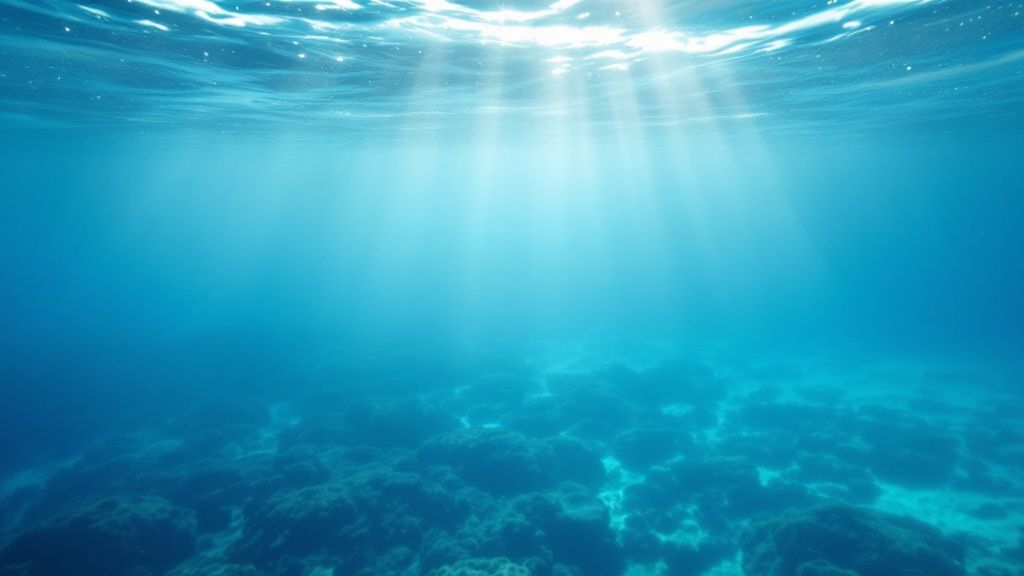
Prime Locations for Your Kona Manta Ray Snorkel Adventure
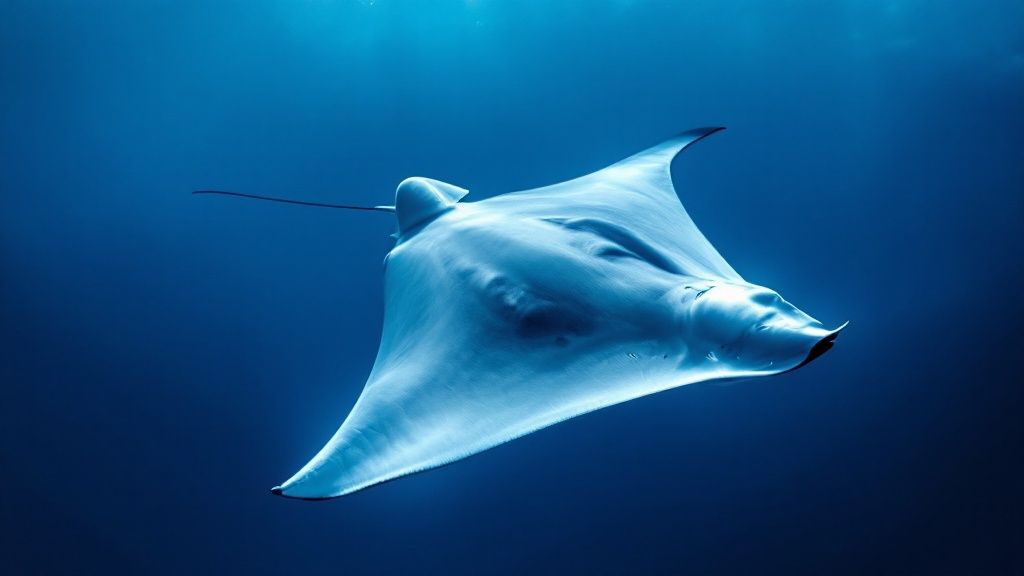
Kona, Hawaii, is renowned for its incredible manta ray viewing opportunities. Two distinct locations, Manta Village and Manta Heaven, offer unique experiences for those seeking an unforgettable snorkel adventure. Both locations boast consistent manta ray sightings, ensuring a high probability of encountering these gentle giants.
Manta Village: The Calm Bay
Manta Village, nestled within Keauhou Bay, is known for its shallow, sheltered waters. This environment makes it a perfect choice for beginners or anyone who prefers calmer conditions. The shallow depth allows ample light penetration, creating excellent visibility, even during nighttime snorkels.
The bay’s protected location minimizes currents and surface chop, contributing to a more relaxed experience. This makes it a popular choice for families with children or those new to snorkeling.
Manta Heaven: Thrilling Open Ocean Encounters
For a more adventurous experience, Manta Heaven, located off the Kona coast near the airport, awaits. This site lies in deeper waters, often attracting larger manta rays and showcasing dynamic feeding behaviors.
While the deeper water and potential for stronger currents might present a slightly greater challenge, the rewards can be spectacular. Witnessing the breathtaking underwater ballet of mantas performing acrobatic feeding loops is truly a sight to behold.
Why These Locations are Manta Ray Hotspots
Both Manta Village and Manta Heaven have become manta ray hotspots due to a combination of factors. The underwater terrain at both sites features gentle slopes and rocky outcroppings, which create the ideal feeding grounds. These slopes generate updrafts of nutrient-rich water, carrying plankton to the surface, the manta rays' primary food source.
These locations also boast cleaning stations. These are areas where small fish gather to remove parasites from the mantas' skin, further enhancing the appeal for these gentle giants. Manta Heaven's deeper waters often experience stronger currents, which bring in more plankton and attract larger groups of mantas. Researchers regularly monitor manta ray sightings along the Kona coast, including both Manta Village and Manta Heaven, collecting valuable data on individual mantas and their behavior. Manta Ray Advocates provides further information and statistics on these magnificent creatures.
To help you choose the perfect snorkel location, we've compiled a comparison table:
To help you choose the perfect snorkel location, we've compiled a comparison table highlighting the key differences between Manta Village and Manta Heaven:
Kona Manta Ray Snorkel Sites Comparison: This table summarizes the main features of each site, including average manta sightings, best time to visit, experience level, accessibility, and any special features.
| Location | Average Mantas Sighted | Best Time | Experience Level | Accessibility | Special Features |
|---|---|---|---|---|---|
| Manta Village | 3-5 | Night | Beginner | Easy, calm entry | Sheltered bay, shallow water |
| Manta Heaven | 5-10 | Night | Intermediate | Boat access | Deeper water, open ocean |
This table clearly outlines the distinct advantages of each site. Manta Village offers calm, accessible waters, perfect for beginners. Manta Heaven, while requiring a bit more experience, offers the potential to see more mantas and witness their impressive feeding displays.
Choosing the Right Snorkel Adventure
Choosing between Manta Village and Manta Heaven ultimately depends on your experience level and personal preferences. Manta Village is an excellent choice for families, first-time snorkelers, and those seeking a relaxed experience in calmer waters. More experienced snorkelers seeking a more thrilling encounter with potentially larger groups of mantas in deeper water might prefer Manta Heaven. Considering factors like water conditions and typical manta ray behavior at each location will help ensure an unforgettable experience.
Preparing for Your Unforgettable Manta Encounter
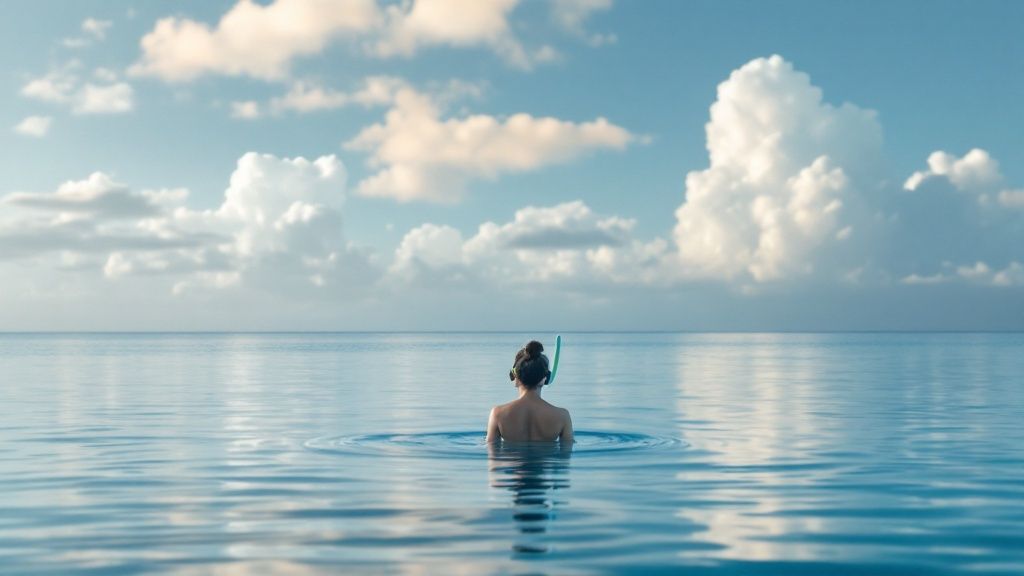
Getting ready for your Kona manta ray snorkel trip can truly elevate the whole experience. A little planning goes a long way, from choosing the right equipment to understanding how to interact respectfully with these gentle giants.
Essential Gear for Kona Manta Ray Snorkel
The right gear can significantly impact your comfort and enjoyment. Here's a quick rundown of the essentials:
- Wetsuit: A 3mm wetsuit is generally recommended for warmth and flexibility in Hawaiian waters.
- Mask: Finding a mask that fits your face perfectly is essential for clear vision and leak prevention. Try a few different styles before your tour.
- Fins: Fins help you move through the water efficiently, conserving energy so you can focus on the manta rays.
- Underwater Camera: A GoPro or similar underwater camera is perfect for capturing those magical low-light moments. Don't forget a float strap!
With these basics, you'll be well-prepared to make the most of your manta ray encounter.
Preparing for the Boat Journey and Water Entry
A little pre-trip planning can ease any anxieties and ensure a smooth start to your snorkel adventure.
- Seasickness: If you're prone to seasickness, consider taking precautions like motion sickness medication or ginger supplements.
- Anxiety: Deep breathing exercises can help calm any nerves about entering the water, particularly at night. Visualize the experience and focus on the excitement.
- Boat Essentials: Pack a small dry bag with a towel, a change of clothes, and any personal items.
- Water Entry: Pay close attention to your guide's instructions for a safe and easy water entry. They're there to help!
These simple steps contribute to a comfortable and stress-free experience.
Maximizing Your Manta Ray Encounter
Finally, preparing yourself both physically and mentally can truly enhance your manta ray encounter.
- Pre-Snorkel Nutrition: A light meal a few hours beforehand can help maintain your energy and prevent nausea. Avoid anything too heavy or greasy.
- Breathing Techniques: Practicing slow, deep breaths before and during your snorkel can improve your comfort and relaxation in the water.
- Mental Presence: Stay present and focused on the experience. Don't get overwhelmed by the majesty of the manta rays, but simply enjoy the magic of the moment. Remember the ethical considerations and avoid touching the mantas.
These final preparations will ensure you're ready for a truly unforgettable Kona manta ray snorkel adventure.
Day vs. Night: Choosing Your Perfect Manta Ray Experience
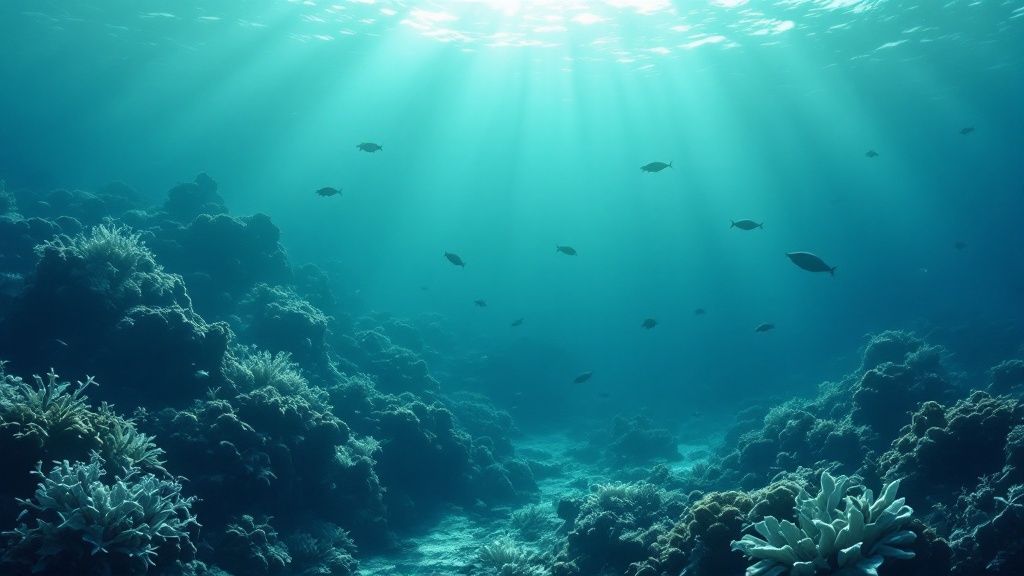
Planning a manta ray snorkel trip in Kona? One of the biggest decisions you'll face is choosing between a daytime or nighttime excursion. Both offer incredible encounters, but each has its own distinct charm. Understanding the differences will help you pick the perfect experience for you.
Daytime Encounters: Reefs, Sunlight, and Relaxed Exploration
Daytime manta ray snorkeling in Kona offers a unique perspective. The sun illuminates the vibrant coral reefs, showcasing the colorful ecosystem the mantas call home. The generally calmer waters make for a relaxed experience, ideal for families with young children or first-time snorkelers. Visibility is typically excellent, providing expansive views of the underwater world.
However, manta ray sightings during the day are less predictable. You might see them cruising or feeding, but the dramatic feeding frenzies characteristic of nighttime viewings are less common. Daytime tours often prioritize reef exploration, with manta rays as a welcome bonus.
Nighttime Encounters: The Ballet of the Mantas
Night transforms the manta ray snorkel into something truly special. Under the cover of darkness, specialized lights attract plankton, creating a feast for the mantas. This leads to spectacular feeding displays, with mantas performing acrobatic loops and barrel rolls as they devour the plankton. The illuminated water creates a surreal, almost otherworldly atmosphere.
Nighttime snorkels, however, present some challenges. The darkness can be disorienting, and the water is generally cooler. Some may find the experience more intense, especially those new to night snorkeling.
Practical Considerations: Price, Crowds, and Photography
Several practical factors also influence your choice. Price is one consideration, with nighttime tours generally more expensive due to the specialized equipment. Crowds can vary, though nighttime tours are often more popular because of the dramatic feeding displays. Photography opportunities also differ. Nighttime photography requires specialized underwater camera settings and equipment.
To help you visualize the differences, we've compiled a comparison table:
To help you choose the best experience for you, we’ve put together a comparison table:
Day vs. Night Manta Ray Snorkel Experience:
| Feature | Daytime Experience | Nighttime Experience | Best For |
|---|---|---|---|
| Visibility | Excellent, broad reef views | Focused on illuminated mantas | Reef enthusiasts, general snorkelers |
| Manta Activity | Less predictable, cruising | Concentrated feeding frenzies | Thrill-seekers, photographers |
| Water Conditions | Calmer, warmer | Slightly cooler, can be choppy | Families, first-timers |
| Price | Generally lower | Generally higher | Budget-conscious travelers |
| Crowds | Can vary, often less crowded | Can vary, often more crowded | Those seeking a more intimate experience |
| Photography | Easier, standard settings | More challenging, specialized gear | Underwater photographers |
This table summarizes the key distinctions between daytime and nighttime manta ray snorkel adventures. Carefully weighing these factors will ensure you choose the perfect time to create your own unforgettable manta ray encounter. Book your Kona Snorkel Trip today!
What Happens During Your Kona Manta Ray Snorkel
Getting ready for a manta ray snorkel adventure in Kona? Get ready for an amazing experience! This guide walks you through a typical manta ray snorkel trip, from leaving the dock to returning with incredible memories.
Setting Sail: The Boat Journey
Your adventure begins with a scenic boat ride along the Kona coastline. As you cruise towards the manta ray viewing area, your guides will provide a safety briefing, covering everything from how to enter the water to proper snorkeling techniques. This is the perfect time to ask questions about the mantas and the local environment. Your guides are a wealth of information and will share their knowledge and passion, building anticipation for the encounter ahead.
Entering the Manta's Realm
Once you arrive at the snorkel site – often Manta Village or Manta Heaven – the crew will help you enter the water safely. Snorkelers will gather around submerged light boards. These specialized lights attract plankton, the manta rays' main food source, and become the focal point of your experience.
The Manta Ray Ballet Begins
As the plankton accumulates, the manta rays appear, often as if from nowhere. These gentle giants will glide through the illuminated water, performing captivating feeding loops and barrel rolls just inches from your mask. It’s a mesmerizing display, often referred to as the "manta ray ballet." You’ll have the chance to observe their unique spot patterns, which allow researchers and guides to identify individual mantas. The guides will point out manta ray approach patterns and explain their behavior, enriching your understanding of these amazing creatures.
Up Close and Personal: A Magical Encounter
Floating weightlessly as these massive, yet graceful, creatures glide within inches of you is a truly unforgettable experience. Despite their impressive size (wingspans range from 5 to 10 feet, with some reaching 14 feet or more!), mantas are known for their gentle nature and seem completely unbothered by humans. This close proximity allows for incredible observation and creates a connection with these magnificent creatures. A Kona manta ray snorkel is more than just an activity; it’s a chance to connect with nature in a profound way, leaving you with memories to cherish. Always remember to heed your guide's instructions, especially regarding safe and respectful interaction with the mantas.
Return to Shore: Memories Made
After about 20-25 minutes in the water, you'll climb back on the boat, filled with awe and wonder. The journey back to shore provides the perfect opportunity to reflect on your manta ray encounter. Share stories and photos with your fellow snorkelers, discussing the experience and solidifying your newfound appreciation for these gentle giants. You'll undoubtedly be excited to share your incredible Kona manta ray snorkel adventure with everyone back home! Ready to book? Check out this Kona manta ray snorkel experience.
Embracing Ethical Kona Manta Ray Snorkeling
Beyond the thrill of a Kona manta ray snorkel lies our responsibility to these magnificent creatures. Ensuring your manta experience supports, rather than harms, these protected animals is crucial. Ethical snorkeling isn't just about following rules; it’s about understanding the why behind them and becoming an advocate for ocean conservation.
Respecting the Gentle Giants: Science-Backed Guidelines
Ethical interactions with manta rays revolve around respecting their natural behaviors and minimizing disturbance. This includes maintaining a safe distance and avoiding any physical contact. Touching a manta ray, for instance, can disrupt its delicate mucus coating, which acts as a vital protective barrier against infections and parasites. Proper positioning in the water is also essential, making sure you don’t obstruct the mantas’ natural movement or feeding patterns.
-
No Touching: Never attempt to touch a manta ray. Their protective mucus layer is easily disrupted.
-
Maintain Distance: Give the mantas plenty of space. Observe their behavior and allow them to approach you, rather than the other way around.
-
Follow Guide Instructions: Listen carefully to your guide’s instructions. They are trained to ensure both your safety and the well-being of the manta rays.
These guidelines are based on scientific research and are vital for preserving the health and natural behaviors of these gentle giants.
Supporting Research and Conservation: How Operators Contribute
Legitimate Kona manta ray snorkel operators play an active role in manta ray research and conservation. Many operators participate in identification programs, meticulously photographing the unique spot patterns on each manta's underside. These photographs are then used to track individual mantas, contributing to valuable population studies and habitat monitoring.
This data provides crucial insights into manta ray behavior, migration patterns, and overall population health. Researchers can, for example, track the movements of individual mantas over time. This helps them identify critical habitats and understand how environmental changes affect these populations.
The Power of Manta Tourism: Economic Incentives and Education
Manta ray tourism creates a powerful economic incentive for conservation. By generating revenue directly linked to the well-being of manta rays, it encourages local communities and businesses to protect these animals and their habitat. This creates a sustainable cycle where tourism supports conservation efforts, ensuring future generations can experience the magic of a Kona manta ray snorkel.
Responsible manta ray tours also provide valuable educational opportunities. Guides share information about manta ray biology, behavior, and the importance of conservation, transforming participants into ocean advocates. This education extends beyond the tour itself, inspiring continued support for marine conservation long after visitors leave Hawaiian waters.
Make a Difference: Choose a Responsible Operator
Choosing a responsible operator is paramount for ethical Kona manta ray snorkeling. Look for operators who prioritize sustainability, adhere to strict interaction guidelines, and actively participate in research and conservation efforts. By making informed choices, you can ensure your manta ray encounter contributes to the long-term well-being of these incredible creatures.
Book your unforgettable and ethical Kona manta ray snorkel adventure with Kona Snorkel Trips today!
